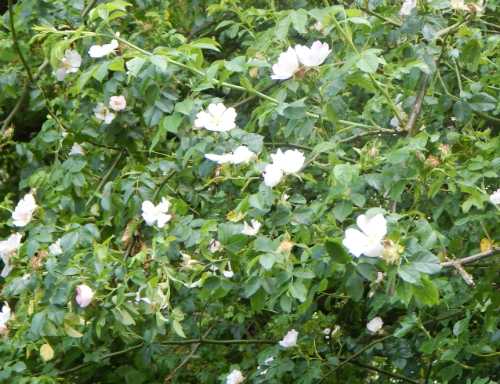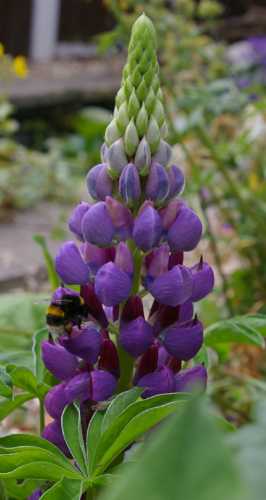Bees LOVE Caryopteris - And So Do Butterflies!
It would be hard to select my top ten shrubs for bees because after all, there are so many.
But if I really had to create such a list, then Caryopteris x clandonensis (Bluebeard) would definitely be included.
Caryopteris x clandonensis (Bluebeard) Is A Bee-garden Must Have!
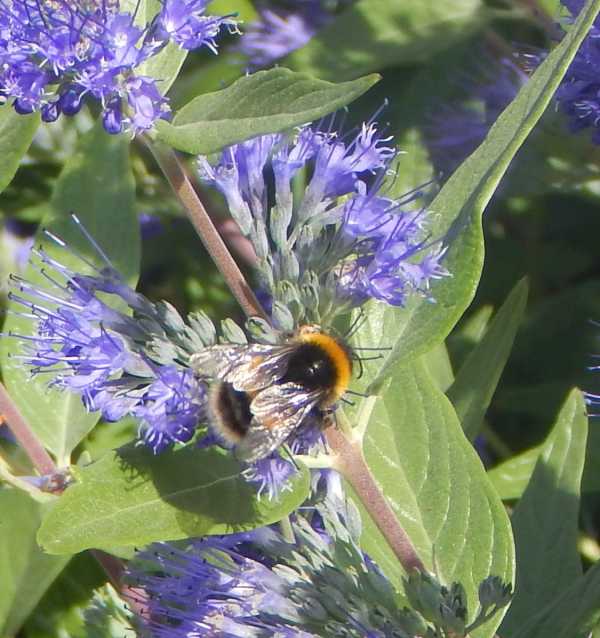 Bumble bee (probably Bombus lucorum) foraging on Bluebeard
Bumble bee (probably Bombus lucorum) foraging on BluebeardCaryopteris x clandonensis is an absolute magnet for bees (and butterflies) but is perhaps not so well-known as some other blue-flowered shrubs, such as Lavender and Ceanothus.
Yet I hope that will change. I have two of these gorgeous shrubs in my garden, having first discovered Caryopteris (Bluebeard) a few years ago.
A swathe of Caryopteris x clandonensis were planted in a public garden I visited, and they were extremely popular with bees and butterflies.
It was even notable that some other (usually popular) flowers were left alone, whilst the bees buzzed busily on the stretch of Bluebeard.
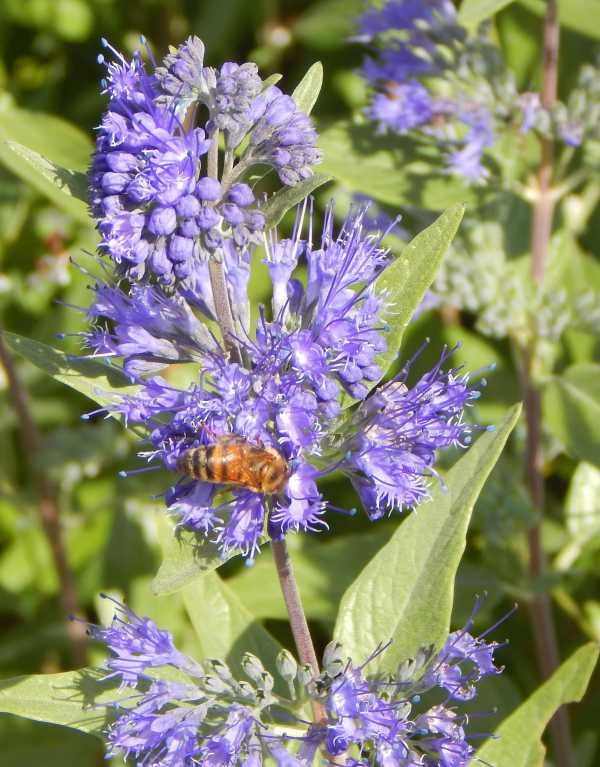 Honey bee Apis mellifera on Bluebeard
Honey bee Apis mellifera on BluebeardOnce I had seen how popular these shrubs were, I looked out for them at my local garden centre, and purchased two specimens of Caryopteris x clandonensis 'Heavenly Blue'.
This year, I intend to purchase more.
Why are Caryopteris x clandonensis popular with bees?
- Food for bees
Firstly, Caryopteris x clandonensis provides both nectar and pollen for bees.
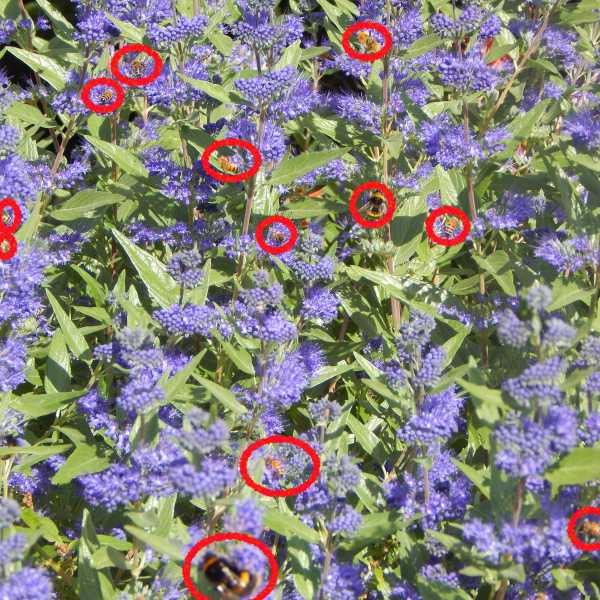 Above: No fewer than 12 bees of different species, are foraging simultaneously on a small section of Caryopteris x clandonensis.
Above: No fewer than 12 bees of different species, are foraging simultaneously on a small section of Caryopteris x clandonensis.- Efficient foraging
These lovely shrubs offer bees many soft, bushy clusters of blue flowers at intervals up each single woody stem.
The abundance of flowers in a concentrated location provides the opportunity for bees (and butterflies) to forage efficiently, reducing the need to use energy in flight between flowers.
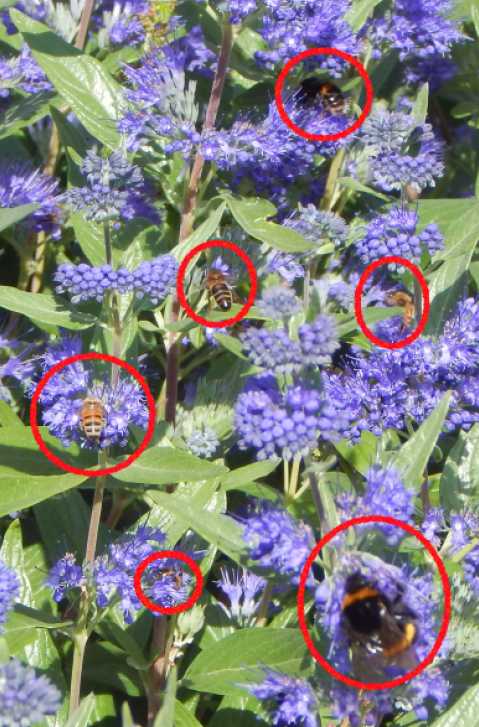
- Flower season
Caryopteris x clandonensis is also very useful, in that it provides food for bees from mid-late summer through to autumn.
During this time frame, many bumble bee colonies will be at their peak, and newly emerged bumble bee queens (gynes) will be feeding to lay down energy and fat reserves in preparation for their winter hibernation (or diapause).
Indeed, many of the photographs I have taken appear to feature bumble bee queens (not all of the photographs taken appear on this page).
Honey bees on the other hand, will also be keen to build up their nectar stores for honey to sustain them through the winter months.
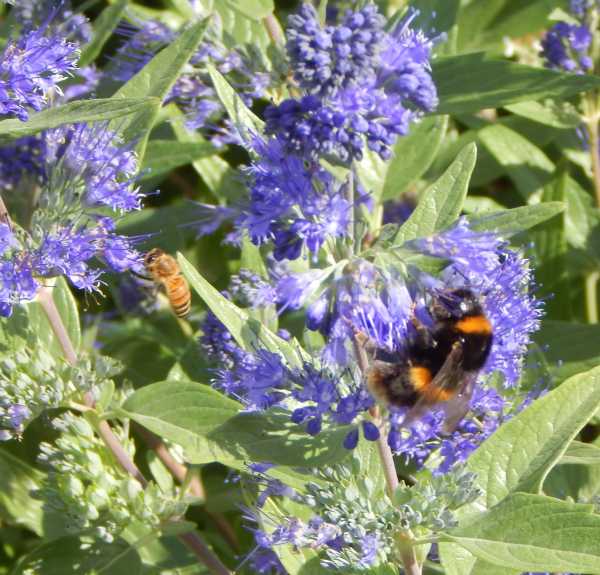 Bumble bee (probably Bombus terrestris queen) and honey bee (Apis mellifera on Caryopteris x clandonensis
Bumble bee (probably Bombus terrestris queen) and honey bee (Apis mellifera on Caryopteris x clandonensis- Aroma
Bees are attracted to scent, and sent is regarded as a pollinator syndrome1.
Scent is important. Social bees quickly learn to associate scent with the presence of nectar, and their ability to do this is generally faster and more reliable than their ability to learn visual cues2.
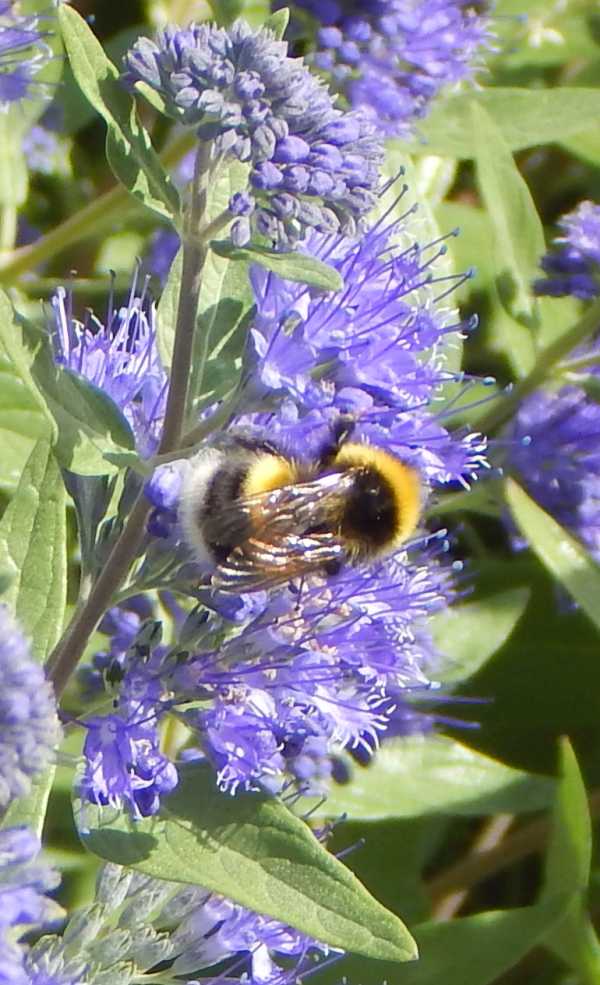 A very beautiful Bombus hortorum - Garden Bumble bee foraging on Bluebeard
A very beautiful Bombus hortorum - Garden Bumble bee foraging on BluebeardGrowing Caryopteris x clandonensis for bees (and butterflies)
Choose a sunny, sheltered spot in your garden and allow for growth of up to a metre in height and the same for spread - but more compact varieties are available.
In my experience, this shrub will tolerate some light shade, but as I write, I know I'll be moving both of mine into a spot in full sun this year.
Cuttings can be taken, so you can share these beautiful shrubs with your friends, creating more feeding stations for bees, or build up your own stock.
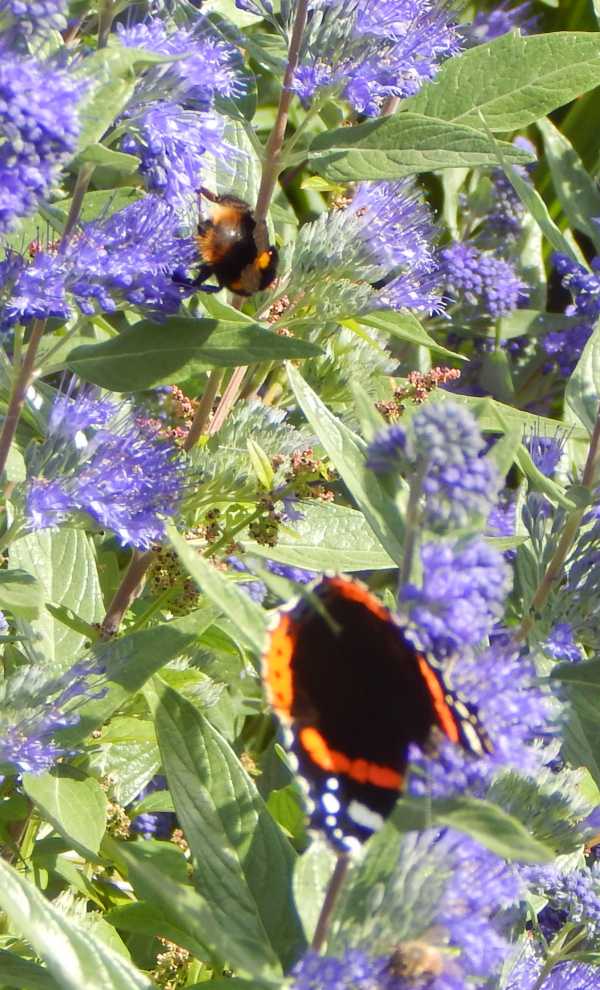 A Buff-tailed bumble bee and Red Admiral butterfly on Bluebeard
A Buff-tailed bumble bee and Red Admiral butterfly on BluebeardRecommended varieties
Note, the following shrubs are deciduous.
Caryopteris × clandonensis Heavenly Blue:
This is the variety I have in my garden. It has lovely blue flowers and is very attractive to bees.
Caryopteris × clandonensis Sterling Silver:
Lovely blue flowers are displayed on stunning silvery grey foliage.
Caryopteris × clandonensis Hint of Gold ('Lisaura') (PBR):
This gorgeous shrub features cobalt blue flowers and and golden-yellowish-green leaves adorn the stems.
Caryopteris × clandonensis 'White Surprise':
A lovely Caryopteris with violet-blue flowers and striking dark green leaves edged with creamy white.
Caryopteris × clandonensis Grand Bleu:
If you are looking for a more compact Caryopteris, this might be the one for you. It spreads to about half that of 'Heavenly Blue' but it will grow to a similar height.
Caryopteris × clandonensis Stephi ('Lissteph') (PBR):
If you are looking for a pink variety, this is one to consider. I have no personal experience with it, but I understand it is popular with bees and butterflies.
References
1. Burkle LA, Runyon JB. The smell of environmental change: Using floral scent to explain shifts in pollinator attraction. Appl Plant Sci. 2017 Jun 5;5(6):apps.1600123. doi: 10.3732/apps.1600123. PMID: 28690928; PMCID: PMC5499301.
2. Wright, G.A. and Schiestl, F.P. (2009), The evolution of floral scent: the influence of olfactory learning by insect pollinators on the honest signalling of floral rewards. Functional Ecology, 23: 841-851. https://doi.org/10.1111/j.1365-2435.2009.01627.x
If you found this page helpful or interesting, I'd really be grateful if you would share it with others - if not this page, perhaps another, such as Gardening For Bees.
Thank you so much :) .
